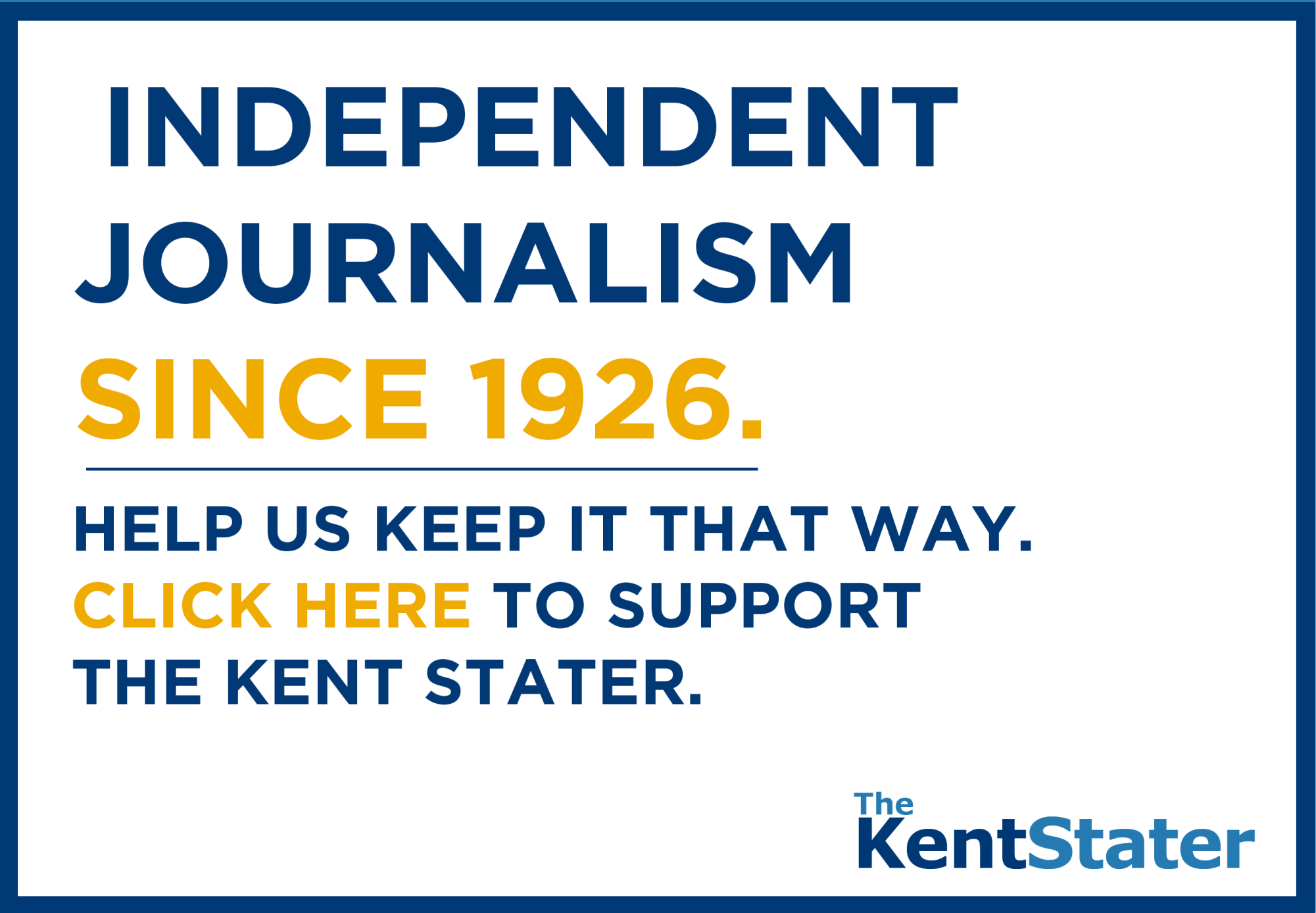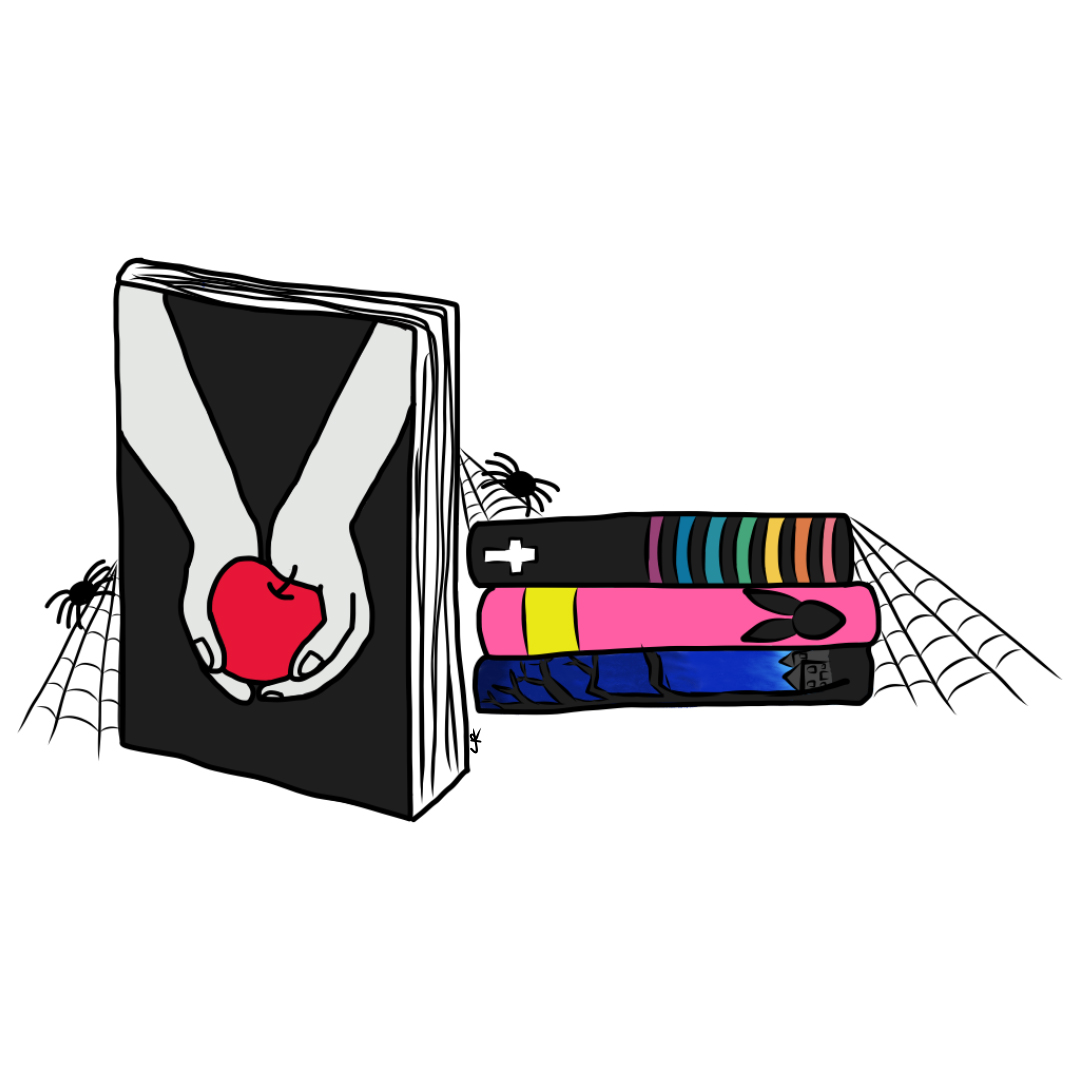Tuition, book fees just the start for some
November 29, 2006
Kent State’s tuition for an in-state undergraduate for the 2006-2007 school year is $8,430. For out-of-state students, that number nearly doubles to $15,862. Books, according to the College Board, on average range from $801 to $904 each year. But for many Kent State students, like Meredith Johnson, the costs don’t stop there.
Materials in, artwork out
Brush in hand, Johnson, a junior crafts major, put the finishing touches on a human figure for her Painting II class. Between brush strokes, she paused to talk about the cost of creating such a work.
Digging through the tubes of color in her paint-stained supply box, Johnson pulled out a small new-looking tube of paint.
“This magenta cost $8,” she said. “Some colors are more than others.”
Johnson said the price of art supplies depends largely on which class a person is taking, but it can range from a couple of dollars for paper to $20 for a canvas to $50 for tools for her jewelry/metals class.
All told, Johnson said she spends more than $1,000 a semester for her supplies and class fees.
Johnson said she believed the painting classes were the most expensive.
She said she’ll typically spend $80 on paint, buy four to five canvasses costing between $5 and $20 each and spend $5 to $20 for brushes.
Brian Smith, manager of All Media Art Supply Co. in Kent, said it’s no secret that art supplies are expensive.
“It’s the nature of them,” he said. “A lot of it is the cost to manufacture things.”
Smith said paints are particularly expensive because they often contain toxic chemicals that require more processing.
While expensive, Johnson said she’d rather buy art supplies than books.
“A lot of people never open their books,” she said. “You actually get to use the supplies.”
Johnson usually buys supplies twice a semester, once at the beginning and again toward the end.
“It’s nice to have fresh, new stuff for the end of the semester and finals,” she said.
And while some materials, such as the brass for her jewelry/metals class, are provided by the school, nearly all classes have extra fees associated with them that help cover the cost of things provided by the school.
Though pricey, Johnson thinks it’s worth spending the money.
“It’s a good learning experience,” she said, “as long as you like what you’re doing.”
Building for tomorrow
Steven Faul sat in front of one of the large windows in the third floor of Taylor Hall. While the view out his window on the fall day was impressive, Faul was focused on the large sheet of white Bristol paper on the drafting table in front of him.
Faul said he goes through a lot of Bristol paper – a pad and a half through 10 weeks of the semester. He said each pad costs about $35.
It’s just another expense for the freshman architecture major.
“The first week I probably spent $300 on supplies,” he said.
He pointed to a green mat underneath the sheet of Bristol paper. It was one of his first-week purchases.
“This cost $70,” he said.
Along with the mat, he purchased all his drafting tools the first week.
Faul explained students had to buy the mats because the drafting table’s surfaces are badly cut up, making smooth drawing lines impossible. The many lacerations were clearly visible on the corners of the table that his mat didn’t cover.
What really adds up though, Faul said, are the supplies, such as the sticks and glue that go into his models. While not expensive in themselves, the sheer volume Faul goes through when building is substantial.
Earlier in the day, on the other side of Taylor Hall’s design studio, senior Brandi Dodge, a transfer student in her second year of architecture, talked about what goes into her models while she shaded blueprints.
“I always have to buy supplies constantly,” she said.
Dodge said she buys her supplies at Pat Catan’s, an art supply store near her home. The amount she spends per model depends on size, materials and how detailed it must be.
Some models aren’t too expensive to make, she said. The chipboard two-level apartment building model that sat on her table only cost about $5.
Others are more.
“For a final model, $20, plus the preliminaries before that,” she said.
So far, Dodge guessed she had spent about $100, but the semester isn’t done.
“I’ll be spending a lot more,” she said.
Faul said he has spent between $450 and $500 so far this semester.
While Faul was quite certain the benefits of the program outweighed the costs, Dodge wasn’t so sure.
“It’s hard trying to commute, work quite a bit and spend most of my money paying tuition and buying supplies,” Dodge said. “I’m still undecided.”
She said she’s just putting too much time and money into the program.
Faul said there was no doubt it was worth it.
“This is an accredited program,” he said.
Faul said it’s somewhat of a trade-off; the supplies are expensive now, but it will be worth it if he can make “mad bill” in the future.
Taking to the skies
Ilya Poklad stood outside the small operations building at the Kent State Airport, chatting with a flight instructor and another student on a blustery November afternoon.
While being from Maryland doesn’t increase the cost of the program itself, it does increase Poklad’s tuition, as it would for any out-of-stater.
Poklad, a business management major who is minoring in flight technology, wasn’t going up on this day. The next day he’d take a three hour flight in a single-engine Cessna 172. It’s part of his second class in the school, Commercial Flight I.
And it won’t be cheap.
“I’ve spent close to $15,000 for the two classes,” he said.
Poklad said he’s already taken Private Pilot Flight and, after Commercial Flight I, will have four classes remaining before he gets his minor. The cost? About another $25,000.
Like many students, Poklad has both a minor and a major to have a backup plan. Unlike most, his major is his backup plan.
“I can get everything in the (flight) major with a (flight) minor,” he said. The only difference between the two, Poklad said, are technology classes.
Ideally, he wants to be a pilot, but “things don’t always work out,” he said. Poklad said any health ailment could prevent him from being an airline pilot, so his business management major provides a back-fall in an area he has an interest in.
Isaac Nettey, senior director of academic programming for aeronautics, said the flight costs pay numerous expenses, including fuel, which is generally burned at a rate of six gallons per hour, insurance, flight instructors’ wages, aircraft maintenance, and the aircraft themselves. The last three Kent State purchased totaled more than $1 million.
Poklad applied to private schools around the country prior to enrolling in the flight program at Kent State but found Kent State to be the cheapest.
Nettey said Kent State is able to keep their costs low “because we have privilege of affiliation with the university as part of a bona fide academic program.” Generally, students will also find lessons at Kent State are cheaper than private lessons.
To help defray some of the cost, Nettey said there are two internal scholarships available specifically for aeronautics students. One, given by the Kiwanis Club of Stow-Munroe Falls, includes proceeds from the pancake sale at Aviation Day. Two internal scholarships are available for all College of Technology students. Three other endowment scholarships for flight students are in the works.
Mark Evans, student financial aid director, said flight students, like other students with extra costs for their programs, can apply for extra financial aid. The additional aid is assessed and awarded on an individual basis.
External scholarships are also available, and Nettey guessed about one-third of the students have some type of scholarship.
Poklad isn’t part of that one-third.
“I think it’s hard to get a flight scholarship when you’re only minoring,” he said.
In addition to the flight class fees, Poklad said he also must purchase his own maps, headset and Federal Aviation Administration regulation books, which are updated every eight to 12 months. Pilots must have the most up-to-date version, he said.
And while Poklad said those materials aren’t expensive compared to the flight courses themselves, the other costs add up.
But to Poklad, who estimated he’s put twice as much time into his minor than his major, it’s money well spent.
“I think it’s extremely worth it if you like to fly,” he said.
Capturing the moment
Tucked away inside the camera bag Meghan Gauriloff carries when she goes to shoot is about $3,000 worth of equipment.
“I have the basics. I really can’t go above that right now,” she said with a laugh.
Gauriloff, a senior photojournalism major, said the contents of her camera bag are typical of a student in her concentration.
The photo editor of the Burr, she shoots with a Canon 20D digital camera she bought about a year and a half ago for $1,300. She said her camera would be considered semi-professional. A professional camera costs anywhere from $3,000 and up.
“I’ve shot with a Canon since I was in high school,” she said. “It’s just my personal preference.”
It appears to be the personal preference of many people in her major; she estimated the 20D to be the most popular camera among Kent State photojournalism students.
Gauriloff said the $1,300 Canon, which she worked all summer and got some help from her father to purchase, is just for the camera body – no lens, no accessories.
Throw in two lenses, costing $1,200 and $600 and a $300 flash and other accessories such as memory cards, and things add up quickly.
She said she really didn’t realize coming into the photojournalism program how much she was actually going to have to spend.
“I wasn’t shocked that I had to buy a digital camera, but the pricetag shocked me a little,” she said.
Jeff Fruit, director of the School of Journalism and Mass Communication, said concentrations such as video production, broadcast journalism and photojournalism generally have higher costs associated with them because of their level of technological involvement.
And another technological cost may soon be associated with the school. Fruit said it is considering requiring laptop computers for incoming freshmen sometime in the future.
If implemented, Fruit said he didn’t expect the requirement to keep students out of the program because most students purchase a computer before coming to Kent State.
And for those who don’t, a bank of laptops will be made available for some type of rent, Fruit said.
Gauriloff she said she shoots exclusively in digital.
“It appears to be more expensive, but in the long run, it’s going to be cheaper,” she said, explaining that while the cameras themselves are generally more expensive, it cuts out all the cost of film, paper and the chemicals for developing.
One of the challenges of going digital is the fact that technology is constantly changing as new cameras are constantly being released.
Down the road, Gauriloff hopes to get a Canon wide lens, another flash and eventually a new camera.
“My camera is outdated,” she said.
Gauriloff is also waiting on a new version of Adobe’s Photoshop to be released.
While she plans on upgrading her equipment, she said much of what she has can be put to use later in the professional world.
Though expensive, Gauriloff likes buying the hardware she needs.
“I feel really good to actually buy nice equipment,” she said. “It’s better to buy pieces you can use for a long time and use every day.”
Contact student finance reporter Tyrel Linkhorn at [email protected].












